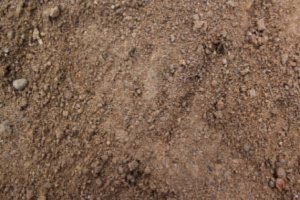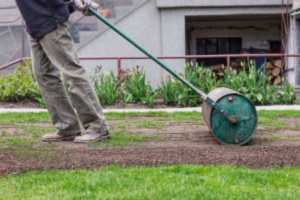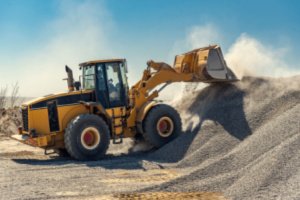Typical front and back yards have roughly six inches of topsoil, but there may be areas where this layer is far thinner. Although home builders and landscapers do their best to provide a level yard when a home is first built, low areas can appear over time, whether it is caused by the decay of old tree roots, underground items like sewer pipes shifting, or other causes.
An uneven yard can pose a host of problems for a property. In addition to making the yard more challenging to mow, dips and uneven spots also pose a tripping danger for children and elderly people navigating the yard. Thankfully, leveling an uneven yard is a fairly simple task, but it is imperative to begin with the right type of fill dirt.
The Best Fill Dirt For Leveling A Yard
Experts recommend topdressing the yard using friable soil, which is a mixture of top soil and sand. It is easiest to spread when applied dry and in smaller particles. However, it is important to first ensure it has the right pH level to suit the area where it will be placed.

Most plants prefer pH levels in the range of 6 to 7, which is slightly acidic to neutral. You can test the pH value of the soil using a simple pH testing kit and amend it with sulfur or lime as needed to ensure it reaches the right level. This is less of a concern, however, if you have no intention of planting anything in the area.
It is always important to look out for clean fill dirt, which means it is free of materials that can harm the environment, animals or humans. Clean fill dirt will be free from corrosive chemicals and highly acidic substances, which is important because soil that contains corrosives can destroy the metals in pipes. It is also free of noxious materials and combustible materials that can easily catch fire and potentially dangerous radioactive substances.
Clean fill dirt is essential for projects like landscaping, where a safe environment is vital. Whether you are leveling your yard or filling in holes, clean or certified fill is a good choice.
Some people choose to make their own topdressing to fill in dips and sunken areas in their yard. This involves mixing three parts of topsoil with three parts of sand and one part of compost with a garden rake in a wheelbarrow or other receptacle. The sand allows for good drainage, while compost gives the soil the nutrients it needs to promote grass growth.
Leveling Your Yard
Leveling your yard is simple once you have the right type of fill dirt. Spring is the best time of year for this type of project thanks to the mild conditions, as it will allow the lawn time to recover before summer heat sets in.

Simply use a shovel to fill in any areas that are lower than the rest of the yard, and then tamp it down using the back of the shovel. Next, spray the area with a gentle spray of water, then tamp it down once again. You will want to continue adding soil until the area stands an inch or two higher than the area surrounding it to allow some margin for settling.
After a few weeks, you will need to check the areas that you filled for settling, adding some soil mixture as needed using the same procedure as before to any spots that are not level.
For Small Sunken Areas Covered With Grass
If you are dealing with small areas in the yard that are sunken and covered with healthy grass, you can use a technique known as “sweeping the dirt under the carpet”. Simply cut through the turf around the edges of the area that is sunken with a sod cutter or flat shovel in clean, vertical cuts to prevent root damage.
Pull the patch of turf off gently and set it aside, and then spread the soil into the hole until it is level with the surrounding lawn. Be sure to water the soil lightly as you go to remove air pockets and avoid settling in the future. Then, press the patch of grass back into place using your foot or hand and water the grass.
How To Calculate The Amount Of Soil Needed To Level A Yard
You can use a simple formula to calculate the amount of soil you will need to level your yard. First, determine how many inches of soil will be needed to fill in the space as well as the size of the space.
Let’s say you need to fill a 10-foot by 15-foot space with three inches of soil. Begin by converting the inches of soil that you need into feet since the area you are filling is measured in feet: 3 inches of soil equals .25 feet.

Then, multiply the length of the area by the width of the area by the depth of the soil that you will need. In our example, this will be 10 x 15 x .25, which is 37.5 cubic feet.
However, most fill dirt is sold by the cubic yard, so you will need to convert this number into cubic yards by dividing the cubic feet by 27. In our example, 37.5 divided by 27 is 1.3889 cubic yards. Round this figure up to determine the amount of soil you will need. In this example, you will want to ask your supplier for 1.4 cubic yards of fill dirt.
Precautions
If unevenness in the yard is appearing near water pipes and accompanied by drainage issues, it is best to consult a professional as a damaged pipe could be causing the problems. This will need to be addressed.
Reach Out To The Northern Virginia Fill Dirt Suppliers
Reach out to the fill dirt and soil suppliers at Dirt Connections to find out how we can support your next project. We offer free estimates and are happy to answer all your dirt-related questions.
Summary

Dirt Connections was started with one goal in mind: providing quality residential and commercial construction services to clients on time and on budget. Reach out for more information on how we can support your next project.
For your convenience our estimates are free and by appointment. Call 703-940-9949 for a free estimate today!









































